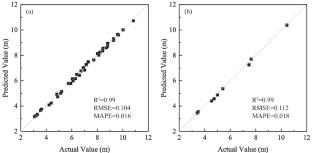Probabilistic landslide-generated impulse waves estimation in mountain reservoirs, a case study
Abstract
Landslide-generated impulse waves (LGIWs) in mountain reservoirs pose serious threats to dam safety. In this paper, the potential LGIWs hazard induced by the ZJ landslide is studied by combining a hybrid SPH-SWEs method and LSTM networks. The hybrid SPH-SWEs method is used to investigate the evolution process of LGIWs, including landslide sliding, impulse wave generation, wave propagation, and running up on the dam. The map of the maximum water level is obtained. Subsequently, 49 calculation samples with different sliding velocities and failure volumes are established using the hybrid model. Based on the numerical samples, the sensitivity of sliding velocities and failure volume on the runup height on the dam is studied, and a LSTM surrogate model is trained to conduct the probabilistic analysis. The results show that the LGIWs is significantly influenced by topography. The influence of sliding velocity on the runup height on the dam surface is greater than that of the failure volume in this case study. The runup height on the dam surface is concentrated between 5.9 m and 7.5 m with a percentage of 84%. The results demonstrate that the combination of the SPH-SWEs method and the LSTM surrogate model can effectively carry out the probabilistic estimation of LGIWs in mountain reservoirs. This study provides technical support for disaster prevention associated with the ZJ landslide and presents a valuable method for assessing the risk of LGIWs.


 求助内容:
求助内容: 应助结果提醒方式:
应助结果提醒方式:


